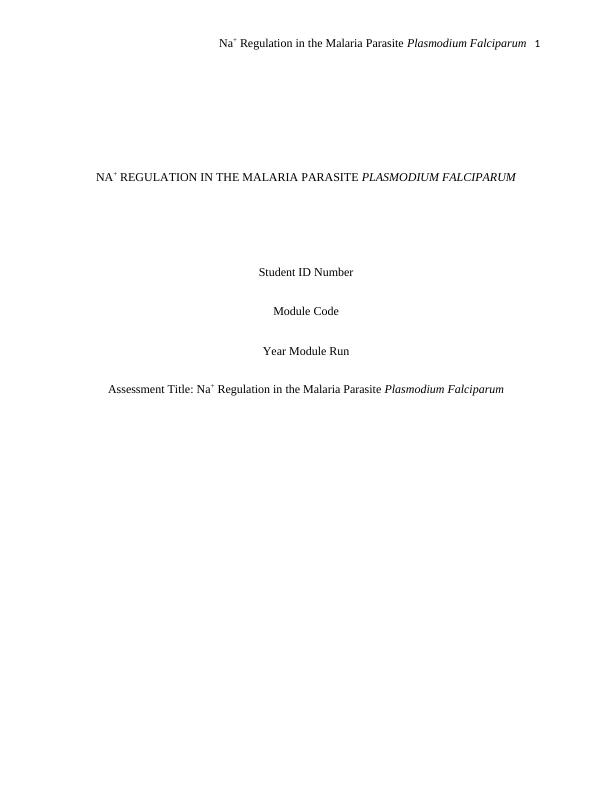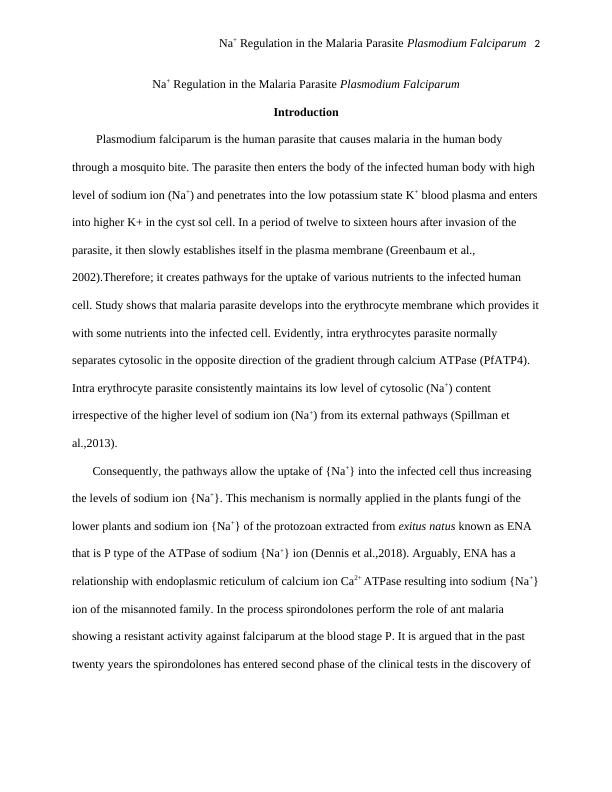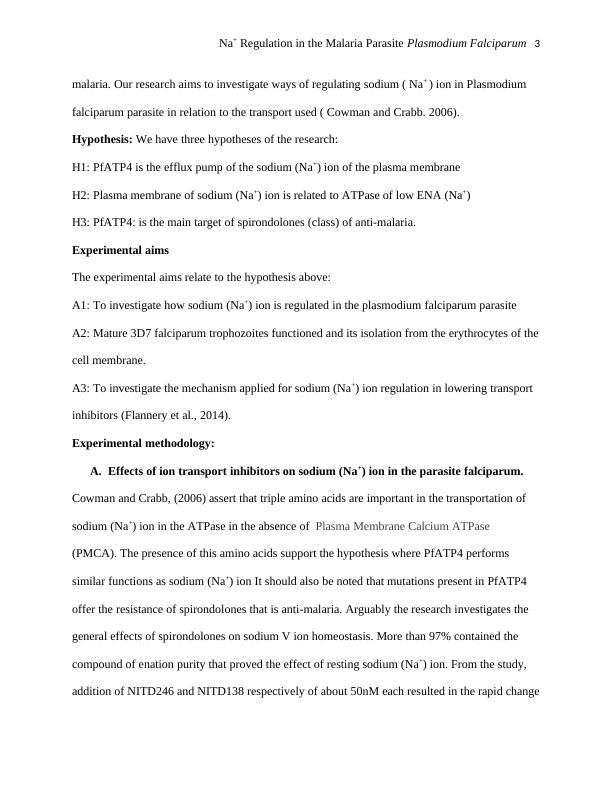Na+ Regulation in the Malaria Parasite Plasmodium Falciparum
Added on 2023-01-23
10 Pages2561 Words32 Views
Na+ Regulation in the Malaria Parasite Plasmodium Falciparum 1
NA+ REGULATION IN THE MALARIA PARASITE PLASMODIUM FALCIPARUM
Student ID Number
Module Code
Year Module Run
Assessment Title: Na+ Regulation in the Malaria Parasite Plasmodium Falciparum
NA+ REGULATION IN THE MALARIA PARASITE PLASMODIUM FALCIPARUM
Student ID Number
Module Code
Year Module Run
Assessment Title: Na+ Regulation in the Malaria Parasite Plasmodium Falciparum

Na+ Regulation in the Malaria Parasite Plasmodium Falciparum 2
Na+ Regulation in the Malaria Parasite Plasmodium Falciparum
Introduction
Plasmodium falciparum is the human parasite that causes malaria in the human body
through a mosquito bite. The parasite then enters the body of the infected human body with high
level of sodium ion (Na+) and penetrates into the low potassium state K+ blood plasma and enters
into higher K+ in the cyst sol cell. In a period of twelve to sixteen hours after invasion of the
parasite, it then slowly establishes itself in the plasma membrane (Greenbaum et al.,
2002).Therefore; it creates pathways for the uptake of various nutrients to the infected human
cell. Study shows that malaria parasite develops into the erythrocyte membrane which provides it
with some nutrients into the infected cell. Evidently, intra erythrocytes parasite normally
separates cytosolic in the opposite direction of the gradient through calcium ATPase (PfATP4).
Intra erythrocyte parasite consistently maintains its low level of cytosolic (Na+) content
irrespective of the higher level of sodium ion (Na+) from its external pathways (Spillman et
al.,2013).
Consequently, the pathways allow the uptake of {Na+} into the infected cell thus increasing
the levels of sodium ion {Na+}. This mechanism is normally applied in the plants fungi of the
lower plants and sodium ion {Na+} of the protozoan extracted from exitus natus known as ENA
that is P type of the ATPase of sodium {Na+} ion (Dennis et al.,2018). Arguably, ENA has a
relationship with endoplasmic reticulum of calcium ion Ca2+ ATPase resulting into sodium {Na+}
ion of the misannoted family. In the process spirondolones perform the role of ant malaria
showing a resistant activity against falciparum at the blood stage P. It is argued that in the past
twenty years the spirondolones has entered second phase of the clinical tests in the discovery of
Na+ Regulation in the Malaria Parasite Plasmodium Falciparum
Introduction
Plasmodium falciparum is the human parasite that causes malaria in the human body
through a mosquito bite. The parasite then enters the body of the infected human body with high
level of sodium ion (Na+) and penetrates into the low potassium state K+ blood plasma and enters
into higher K+ in the cyst sol cell. In a period of twelve to sixteen hours after invasion of the
parasite, it then slowly establishes itself in the plasma membrane (Greenbaum et al.,
2002).Therefore; it creates pathways for the uptake of various nutrients to the infected human
cell. Study shows that malaria parasite develops into the erythrocyte membrane which provides it
with some nutrients into the infected cell. Evidently, intra erythrocytes parasite normally
separates cytosolic in the opposite direction of the gradient through calcium ATPase (PfATP4).
Intra erythrocyte parasite consistently maintains its low level of cytosolic (Na+) content
irrespective of the higher level of sodium ion (Na+) from its external pathways (Spillman et
al.,2013).
Consequently, the pathways allow the uptake of {Na+} into the infected cell thus increasing
the levels of sodium ion {Na+}. This mechanism is normally applied in the plants fungi of the
lower plants and sodium ion {Na+} of the protozoan extracted from exitus natus known as ENA
that is P type of the ATPase of sodium {Na+} ion (Dennis et al.,2018). Arguably, ENA has a
relationship with endoplasmic reticulum of calcium ion Ca2+ ATPase resulting into sodium {Na+}
ion of the misannoted family. In the process spirondolones perform the role of ant malaria
showing a resistant activity against falciparum at the blood stage P. It is argued that in the past
twenty years the spirondolones has entered second phase of the clinical tests in the discovery of

Na+ Regulation in the Malaria Parasite Plasmodium Falciparum 3
malaria. Our research aims to investigate ways of regulating sodium ( Na+ ) ion in Plasmodium
falciparum parasite in relation to the transport used ( Cowman and Crabb. 2006).
Hypothesis: We have three hypotheses of the research:
H1: PfATP4 is the efflux pump of the sodium (Na+) ion of the plasma membrane
H2: Plasma membrane of sodium (Na+) ion is related to ATPase of low ENA (Na+)
H3: PfATP4: is the main target of spirondolones (class) of anti-malaria.
Experimental aims
The experimental aims relate to the hypothesis above:
A1: To investigate how sodium (Na+) ion is regulated in the plasmodium falciparum parasite
A2: Mature 3D7 falciparum trophozoites functioned and its isolation from the erythrocytes of the
cell membrane.
A3: To investigate the mechanism applied for sodium (Na+) ion regulation in lowering transport
inhibitors (Flannery et al., 2014).
Experimental methodology:
A. Effects of ion transport inhibitors on sodium (Na+) ion in the parasite falciparum.
Cowman and Crabb, (2006) assert that triple amino acids are important in the transportation of
sodium (Na+) ion in the ATPase in the absence of Plasma Membrane Calcium ATPase
(PMCA). The presence of this amino acids support the hypothesis where PfATP4 performs
similar functions as sodium (Na+) ion It should also be noted that mutations present in PfATP4
offer the resistance of spirondolones that is anti-malaria. Arguably the research investigates the
general effects of spirondolones on sodium V ion homeostasis. More than 97% contained the
compound of enation purity that proved the effect of resting sodium (Na+) ion. From the study,
addition of NITD246 and NITD138 respectively of about 50nM each resulted in the rapid change
malaria. Our research aims to investigate ways of regulating sodium ( Na+ ) ion in Plasmodium
falciparum parasite in relation to the transport used ( Cowman and Crabb. 2006).
Hypothesis: We have three hypotheses of the research:
H1: PfATP4 is the efflux pump of the sodium (Na+) ion of the plasma membrane
H2: Plasma membrane of sodium (Na+) ion is related to ATPase of low ENA (Na+)
H3: PfATP4: is the main target of spirondolones (class) of anti-malaria.
Experimental aims
The experimental aims relate to the hypothesis above:
A1: To investigate how sodium (Na+) ion is regulated in the plasmodium falciparum parasite
A2: Mature 3D7 falciparum trophozoites functioned and its isolation from the erythrocytes of the
cell membrane.
A3: To investigate the mechanism applied for sodium (Na+) ion regulation in lowering transport
inhibitors (Flannery et al., 2014).
Experimental methodology:
A. Effects of ion transport inhibitors on sodium (Na+) ion in the parasite falciparum.
Cowman and Crabb, (2006) assert that triple amino acids are important in the transportation of
sodium (Na+) ion in the ATPase in the absence of Plasma Membrane Calcium ATPase
(PMCA). The presence of this amino acids support the hypothesis where PfATP4 performs
similar functions as sodium (Na+) ion It should also be noted that mutations present in PfATP4
offer the resistance of spirondolones that is anti-malaria. Arguably the research investigates the
general effects of spirondolones on sodium V ion homeostasis. More than 97% contained the
compound of enation purity that proved the effect of resting sodium (Na+) ion. From the study,
addition of NITD246 and NITD138 respectively of about 50nM each resulted in the rapid change

End of preview
Want to access all the pages? Upload your documents or become a member.
Related Documents
Na+ Regulation in Intraerythrocytic Parasite responsible for causing malaria Involves a P-type ATPaselg...
|5
|1292
|80
Na+ Regulation in the Malaria Parasite Plasmodium falciparumlg...
|1
|1180
|23
Na+ Regulation in the Malaria Parasite Plasmodium falciparumlg...
|2
|1199
|89
Na+ Regulation in the Malaria Parasite Plasmodium falciparumlg...
|1
|1179
|66
